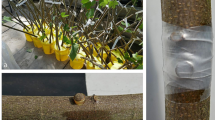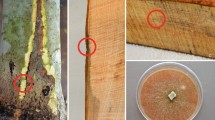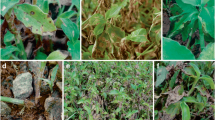Abstract
The main constraint and continuing threat to cocoa production in Latin America is disease caused by two basidiomycete fungi belonging to the genus Crinipellis (Agaricales), both of which are currently on an invasive front. Classical biological control, in which coevolved natural enemies are considered to offer the most potential for sustainable control of invasive alien organisms, is investigated as a management strategy. Our initial approach has been to search for the suspected coevolved host (Theobroma gileri) of one of these pathogens, Crinipellis roreri, the causal agent of frosty pod rot, in the mesic forests of north-west Ecuador; to isolate the endophytes and mycoparasites associated with both host and pathogen; to screen selected fungi in the greenhouse and laboratory, in order to determine their biocontrol potential. Endophytes were isolated directly in the field from healthy tree boles and pods, and over 40 genera were recorded, mainly representing anamorphs of Hypocreales in the genera Acremonium, Clonostachys, Trichoderma and Verticillium, as well as basidiomycetes belonging to the Agaricales and Polyporales. Of the endophytic fungi tested, most can be inoculated into and recovered from asymptomatic cocoa seedlings. Twenty-eight mycoparasitic species were isolated from diseased pods and selected mycoparasites as well as endophytes were screened against C. roreri using the pre-colonised plate method. Consistently high mycoparasitism of the C. roreri pseudostroma was demonstrated, particularly by a complex of Clonostachys and Trichoderma species.
Similar content being viewed by others
References
Arnold AE, Maynard Z, Gilbert GS (2001) Fungal endophytes in dicotyledonous neotropical trees: patterns of abundance and diversity. — Mycological Research 105: 1502–1507.
Baker RED, Holliday P (1957) Witches’ broom disease of cacao (Marasmius perniciosus Stahel). — Phytopathological Papers 2: 1–42.
Baker RED, Cope FW, Holliday P, Bartley BG, Taylor DG (1954) The Anglo-Colombian cacao collecting expedition. Report of Cacao Research 1953. St. Augustine, Trinidad: Imperial College of Tropical Agriculture, 8–18.
Bills GF (1996) Isolation and analysis of endophytic fungal communities from woody plants. In Redlin SC, Carris, LM (eds) Endophytic Fungi in Grasses and Woody Plants: Systematics, Ecology and Evolution pp. 31–65. APS Press, St. Paul, USA.
Bissegger M, Sieber TM (1994) Assemblages of endophytic fungi in coppice shoots of Castanea sativa. — Mycologia 86: 648–655.
Carroll G (1988) Fungal endophytes in stems and leaves: from latent pathogen to mutualistic symbiont. — Ecology 69: 2–9.
Ciferri R, Parodi E (1933) Descrizione del fungo che causa la “Moniliasi” del cacao. — Phytopathologische Zeitschrift 6: 539–542.
Clay K (1990) Fungal endophytes of grasses. — Annual Review of Ecology and Systematics 21: 275–297.
Cuatrecasas J (1953) Une nouvelle espéce de Theobroma. — Revue Internationale de Botanique Appliquee d’Agriculture 33: 562–565.
Cuatrecasas J (1964) Cacao and its allies: a taxonomic revision of the genus Theobroma. — Contributions from the United States Herbarium 35: 379–614.
Dodson CH, Gentry AH (1991) Biological extinction in western Ecuador. — Annals of the Missouri Botanical Garden 78: 273–295.
Evans HC (1980) Pleomorphism in Crinipellis perniciosa, causal agent of witches’ broom disease of cocoa. — Transactions of the British Mycological Society 74: 515–523.
Evans HC (1981) Pod rot of cacao caused by Moniliophthora (Monilia) roreri. — Phytopathological Papers 24: 1–44.
Evans HC (2002a) Invasive neotropical pathogens of tree crops. In Watling R, Frankland JC, Ainsworth AM, Isaac S, Robinson CH (eds) Tropical Mycology 2: Micromycetes, pp. 135–152. CABI Publishing, Wallingford, UK.
Evans HC (2002b) Biological control of weeds. In: Kempken F (ed) The Mycota XI: Agricultural Applications, pp. 235–152. Springer-Verlag, Berlin.
Evans HC, Stalpers JA, Samson RA, Benny GL (1978) On the taxonomy of Monilia roreri, an important pathogen of Theobroma cacao in South America. — Canadian Journal of Botany 56: 2528–2532.
Evans HC, Krauss U, Rios RR, Zecevich TA, Arevalo-Gardini E (1998) Cocoa in Peru. — Cocoa Growers’ Bulletin 51: 7–22.
Evans HC, Holmes KA, Phillips W, Wilkinson MJ (2002) What’s in a name: Crinipellis, the final resting place for the frosty pod rot pathogen of cocoa? — Mycologist 16: 148–152.
Fisher PJ, Petrini O, Petrini LE, Sutton BC (1994) Fungal endophytes from the leaves and twigs of Quercus ilex L. from England, Majorca and Switzerland. — New Phytologist 127: 133–137.
Foley MF, Deacon JW (1985) Isolation of Pythium oligandrum and other necrotrophic mycoparasites from soil. — Transactions of the British Mycological Society 85: 631–639.
Gentry AH (1982) Phytogeographic patterns as evidence for a Chocó refuge. In Prance GT (ed) Biological Diversification in the Tropics, pp. 112–136. Columbia University Press, New York.
Holliday P (1970) Monilia roreri. — CMI Descriptions of Pathogenic Fungi and Bacteria 226: 1–2.
Holliday P (1971) Some tropical plant pathogenic fungi of limited distribution. — Review of Plant Pathology 50: 337–348.
Krauss U, Soberanis W (2001) Biocontrol of cocoa pod diseases with mycoparasite mixtures. — Biological Control 22: 149–158.
Krauss U, Bidwell R, Ince J (1998) Isolation and preliminary evaluation of mycoparasites as biocontrol agents against crown rot of banana. — Biological Control Theory and Application 13: 111–119.
Mitchell CE, Power AG (2003) Release of invasive plants from fungal and viral pathogens. — Nature 421: 625–627.
Omacini M, Chaneton EJ, Ghersa CM, Muller CB (2001) Symbiotic fungal endophytes control insect host — parasite interaction webs. — Nature 409: 78–81.
Petrini O, Fisher PJ. (1990) Occurrence of fungal endophytes in twigs of Salix fragilis and Quercus robur. — Mycological Research 94: 1077–1080.
Rice RA, Greenberg R (2000) Cacao cultivation and the conservation of biological diversity. — Ambio 29: 167–173.
Rodrigues KF (1994) The foliar fungal endophytes of the Amazonian palm Euterpe oleracea. — Mycologia 86: 376–385.
Rorer JB (1926) Ecuador cacao. — Tropical Agriculture, Trinidad 3: 46–47.
Saatchi S, Agasti D, Alfar K, Delabie J, Musinsky J (2001) Examining fragmentation and loss of primary forest in the southern Bahian Atlantic forest of Brazil with radar imagery. — Conservation Biology 15: 857–875.
Samuels GJ, Pardo-Schultheiss R, Hebbar KP, Lumsden RD, Bastos CN, Costa JC, Bezerra JL (2000) Trichoderma stromaticum sp.nov., a parasite of the cocoa witches’ broom pathogen. — Mycological Research 104: 760–764.
Schulz B, Rommert AK, Dammann U, Aust HJ, Strack D (1999) The endophyte-host interaction: a balanced antagonism? Mycological Research 103: 1275–1283.
Shamoun SF, Sieber TN (2000) Colonisation of leaves and twigs of Rubus parviflorus and R. spectabilis by endophytic fungi in a reforestation site in British Columbia. — Mycological Research 104: 841–845.
Suryanarayanan TS, Murali TS, Venkatesan G (2002) Occurrence and distribution of fungal endophytes in tropical forests across a rainfall gradient. — Canadian Journal of Botany 80: 818–826.
Taylor JE, Hyde KD, Jones EBG (1999) Endophytic fungi associated with the temperate palm, Trachycarpus fortunei, within and outside its natural geographic range. — New Phytologist 142: 335–346.
Thorold CA (1975) Diseases of Cocoa. Clarendon Press, Oxford, UK.
Vujanovic V, Brisson J (2002) A comparative study of endophytic mycobiota in leaves of Acer saccharum in eastern North America. — Mycological Progress 1: 147–154.
Author information
Authors and Affiliations
Corresponding author
Rights and permissions
About this article
Cite this article
Evans, H.C., Holmes, K.A. & Thomas, S.E. Endophytes and mycoparasites associated with an indigenous forest tree, Theobroma gileri, in Ecuador and a preliminary assessment of their potential as biocontrol agents of cocoa diseases. Mycol Progress 2, 149–160 (2003). https://doi.org/10.1007/s11557-006-0053-4
Accepted:
Issue Date:
DOI: https://doi.org/10.1007/s11557-006-0053-4




